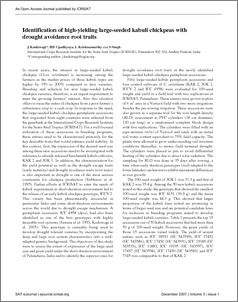Identification of high-yielding large-seeded kabuli chickpeas with drought avoidance root traits
Abstract
Fifty large-seeded kabuli germplasm accessions and four control cultivars of C. arietinum (KAK 2, JGK 1, ICCV 2 and ICC 4958) were evaluated for 100-seed weight and yield in a field trial with two replications at ICRISAT, Patancheru, Andhra Pradesh, India. The 100-seed weight of JGK 1 was 31.3 g and that of KAK 2 was 35.4 g. Among the 50 new kabuli accessions tested in this study, the genotype that showed the smallest 100-seed weight was ICC 8151 (30.9 g) and the mean 100-seed weight was 44.3 g. Results showed that a larger proportion of the kabuli lines tested are promising in terms of larger seed size and are potential candidate lines for inclusion in breeding programmes aimed to develop large-seeded kabuli varieties. The top 15 accessions out of 50 kabuli accessions that had more than 50 g of 100-seed weight were identified. The grain yields of those 15 accessions varied widely. The yield of several entries such as ICC 18591 (EC 543599), ICC 17452 (EC 543586), ICC 17456 (EC 543591), ICC 19189 (EC 543533), ICC 11883, ICC 19195 (EC 543597), ICC 17457 (EC 543594), ICC 17450 (EC 543583) and ICC 7345 was comparable to that of KAK 2. Among the top 15 accessions, none of them matured earlier than ICCV 2 (103 days to maturity). Most of the accessions showed medium to late maturity except ICC 19189 (EC 543533) (108 days). On the other hand, these 15 accessions had as large a RLD as that of ICC 4958 (0.252 cm/cm3) except for four accessions, ICC 18591 (EC 543599) (0.197 cm/cm3), ICC 17452 (EC 543586) (0.198 cm/cm3), ICC 17456 (EC 543591) (0.194 cm/cm3) and ICC 19194 (EC 543593) (0.202 cm/cm3). One accession ICC 17450 (EC 543583) (0.274 cm/cm3) showed significantly larger root length density than ICC 4958. The new kabuli genotypes identified in this work could be utilized as valuable breeding sources for large-seeded kabuli chickpea improvement with drought tolerance

